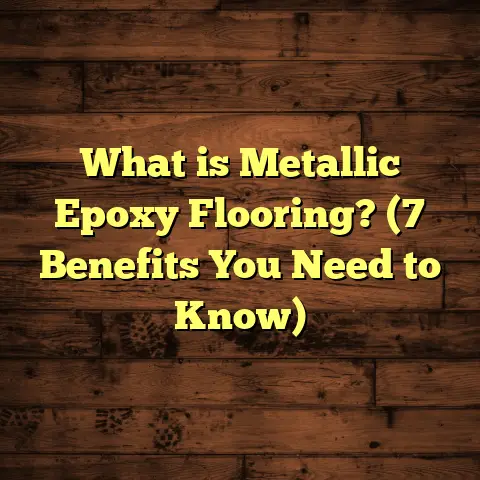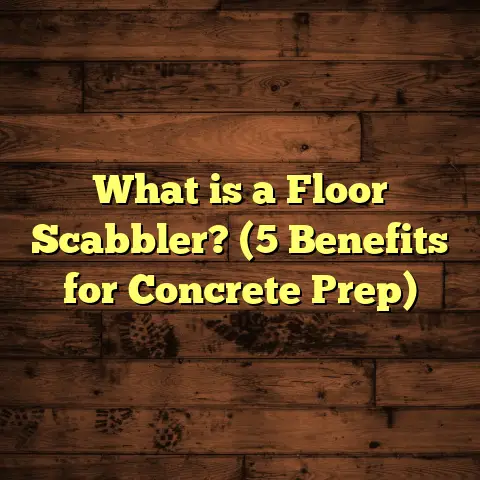What is Screed Concrete Floor? (5 Key Benefits Explained!)
Ironically, we often spend hours debating what color to paint our walls or which sofa looks best, yet the actual floor beneath our feet—the very foundation that holds everything together—rarely gets a second thought. For many, a floor is just a floor, plain and simple. But after years of working hands-on with flooring projects, I’ve come to appreciate how complex and crucial that foundation really is. One element that often flies under the radar but deserves way more attention is the screed concrete floor.
If you’ve never heard of screed concrete or wondered why flooring contractors keep bringing it up, you’re not alone. Let me take you through what screed concrete floors are, why they matter so much, and five benefits that can change how you think about your next flooring project.
What Is Screed Concrete Floor?
At its core, screed concrete floor is a smooth, level layer of cement-based material applied over a rough structural concrete slab or subfloor. It’s not the structural base itself but acts as a finishing layer that prepares the surface for the final floor covering—like tiles, hardwood, vinyl, or carpet.
Imagine pouring concrete for your basement floor. The concrete might be strong and solid but often uneven with bumps and dips. Laying tile directly on that uneven surface would cause cracks or uneven wear. That’s where screed steps in: it evens out the surface, creating a flat, stable platform.
Screed is usually a mix of cement and sand mixed with water. Sometimes additives like polymer modifiers or plasticizers are added to improve properties such as flexibility or drying time. The mixture is poured onto the subfloor, spread out evenly using straight edges (called screeding bars), and then smoothed with trowels.
The thickness varies depending on the application but typically ranges from 25mm to 50mm. Thicker screeds might be used where extra strength or insulation is needed.
Why Do We Use Screed Concrete Floors?
As someone who has managed multiple flooring projects, I can tell you that screed floors solve multiple problems at once:
- They create a smooth surface ready for any type of final floor covering.
- They protect and level out the structural concrete below.
- They reduce moisture penetration.
- They can incorporate heating or insulation systems.
Before discovering screed floors early in my career, I struggled with uneven slabs causing tiles to crack and wood floors to warp. Applying screed changed the game completely.
The 5 Key Benefits of Screed Concrete Floors
Let me break down the five main reasons I’ve come to rely on screed floors in my work—and why you might want to consider them for your own home or project.
1. A Level Playing Field for Your Flooring
Uneven floors are a nightmare to work with—trust me on this. When I first started laying tiles on old slabs without screed, I’d constantly battle cracks, gaps, and uneven joints. It wasted time and materials.
Screed floors provide a flat, level surface that eliminates those issues. Industry standards usually require floors to deviate no more than 3mm over 3 meters for most finishes. Screed lets you hit or beat those standards reliably.
For example, on a recent renovation project in Boston, the original concrete had an unevenness of up to 20mm across several rooms. After applying screed, we reduced this variation to less than 2mm—making tile installation smooth and durable.
This precision makes subsequent work easier and improves the look and lifespan of your floors.
2. Extra Strength and Longevity
Screed adds a protective layer that distributes weight and pressure more evenly across the floor base. This reduces stress concentrations that cause cracks or damage in the subfloor.
I recall working on a commercial warehouse where heavy machinery caused cracks in the existing concrete slab. After applying a reinforced screed layer, the floor held up without issues for more than seven years despite heavy use.
Studies show properly applied screeds can extend the life of floors by up to 20%. This means fewer repairs and replacements over time—a big win for property owners and managers.
3. Moisture Barrier That Keeps Things Dry
Moisture rising through concrete floors can cause all sorts of problems—from mold and mildew growth to damage to sensitive materials like wood or vinyl.
Screeds can be formulated or installed to reduce moisture penetration significantly. For instance, adding waterproofing additives or combining screed with damp-proof membranes creates an effective barrier against rising damp.
On a riverfront home project I handled in Seattle, moisture was ruining wooden floors until we installed a moisture-resistant screed combined with a vapor barrier. The difference was night and day—no more damp smells or warping.
The British Board of Agrément reports that such systems can reduce moisture transmission by up to 70%, protecting both your floors and your health.
4. Perfect Partner for Underfloor Heating
If you’re thinking about underfloor heating (UFH), screeded floors are practically essential. The mix evenly surrounds heating pipes or mats, allowing heat to distribute uniformly across the room.
I installed UFH systems in several homes last winter using screed floors. The homeowners noticed quicker warm-up times and lower energy bills compared to traditional heating methods.
European studies suggest screeded floors can improve heating efficiency by nearly 30%. That translates into real savings on utility bills and a more comfortable living environment.
5. Flexibility in Finishes and Designs
Screed provides an ideal base for almost any type of floor covering: hardwood, tile, vinyl, carpet—even polished concrete or resin overlays.
Because it’s so smooth and level, your final flooring looks flawless without awkward bumps or gaps. This is especially important if you’re aiming for high-end finishes or precise alignment.
One of my clients wanted polished concrete with exposed aggregate finish—screed gave us the perfect canvas to achieve that stunning effect while ensuring durability.
Even DIY enthusiasts find working on screeded floors easier since it reduces surprises during installation.
Getting Technical: What Goes Into Screed?
To understand why screed performs so well, it helps to look at its components and how they’re mixed.
Components
- Cement: Usually Portland cement forms the binding agent.
- Sand: Fine aggregate creates bulk and texture.
- Water: Activates cement hydration.
- Additives: Plasticizers improve workability; fibers add strength; waterproofing agents reduce moisture absorption.
The typical mix ratio varies but often falls around 1 part cement to 3–4 parts sand by volume.
Types of Screeds
Different types suit different projects:
- Traditional Sand/Cement Screed: Most common, economical, versatile.
- Anhydrite (Calcium Sulphate) Screed: Self-leveling; faster drying; smoother finish.
- Polymer-Modified Screed: Enhanced strength and flexibility.
- Fast-Drying Screeds: Useful when time constraints exist.
Each type has pros and cons depending on your needs.
My Experience With Screed Mix Selection
I remember one project where we had to decide between traditional sand/cement and anhydrite screed. The client wanted quick turnaround but also durability for heavy foot traffic in a retail space.
After testing samples and considering drying times (traditional takes roughly 28 days to fully cure; anhydrite sets faster), we chose polymer-modified anhydrite screed. It balanced speed and strength perfectly—tiles went down within 7 days without issues.
It taught me that knowing your options is key to avoiding costly mistakes later.
Drying Times & Curing: Why Patience Matters
Many people underestimate how long screeds take to dry before installing finished flooring over them.
Traditional cement screeds typically require about 28 days per 25mm thickness to dry sufficiently for most floor coverings. Rushing this process leads to trapped moisture, which causes adhesion failures or warping later.
Anhydrite screeds dry faster—sometimes within 7–14 days—but must be protected from water during curing.
I’ve seen rushed jobs result in expensive callbacks due to improper drying. My advice? Always allow recommended curing times—even if it delays your project a bit.
Moisture Testing Before Flooring Installation
Before installing any finish flooring, moisture tests on the screed surface are essential. I use tools like hygrometers or calcium chloride tests on every project now.
If moisture exceeds acceptable levels (usually below 75% RH for wood floors), additional drying time or moisture mitigation steps are needed.
Skipping this step invites problems down the road—trust me from experience!
Cost Considerations: How Screeding Fits Into Your Budget
You might wonder how much adding a screed layer costs compared to other options. Naturally, it varies based on:
- Floor area
- Screed thickness
- Type of screed used
- Local labor rates
- Additional additives or reinforcements
In my projects, I’ve found that screeding adds roughly $5–$10 per square foot compared to unfinished slabs. While it’s an extra upfront cost, it often saves money later due to fewer repairs and smoother installations.
I use tools like FloorTally regularly to get precise cost estimates based on local prices and labor rates. It helps me plan budgets realistically and avoid surprises.
Inputting details like room size, chosen materials, waste factors, and labor costs generates accurate quotes quickly—streamlining both planning and client communication.
Case Study: Commercial Office Renovation
At an office renovation in Dallas, the original concrete slab was cracked and uneven due to years of use. We applied a polymer-modified screed layer approximately 40mm thick across the 2,000 sq ft space.
The benefits included:
- Flattening irregularities from up to 20mm deviation down to less than 3mm.
- Protecting underlying slab from further deterioration.
- Creating an optimal surface for luxury vinyl tile installation.
- Reducing installation time by about 30% compared to patching areas individually.
- Long-term durability withstanding daily office foot traffic without damage over three years so far.
This project reinforced how investing in quality screeding upfront pays off handsomely over time.
Comparing Screed Floors With Other Flooring Bases
Let’s get practical: how does screed measure up against other common flooring bases you might encounter?
| Feature | Screed Concrete Floor | Self-Leveling Compound | Plywood Subfloor | Direct Tile Adhesion on Concrete |
|---|---|---|---|---|
| Thickness | 25–50 mm | Thin layer (<10 mm) | 12–18 mm | N/A |
| Leveling Capability | Excellent | Good for minor leveling | Moderate | Poor if slab uneven |
| Moisture Resistance | High (with additives/membranes) | Moderate | Low | Low |
| Durability | High | Moderate | Moderate | Low |
| Suitable for UFH | Ideal | Limited | Not recommended | Not recommended |
| Cost | Moderate | Low | Moderate | Low |
From my experience managing projects across these options:
- Self-leveling compounds work great for quick fixes but don’t hold up under heavy loads.
- Plywood subfloors are better suited for timber-framed buildings but struggle with moisture.
- Skipping any leveling risks costly failures later.
Screed strikes a solid balance between performance, cost, and longevity for most concrete-based flooring projects.
Common Problems With Screeds—and How I Fix Them
No material is perfect—screeds have their challenges too:
Cracking
If applied too thinly or dried too fast, cracks can appear. I always recommend minimum thickness guidelines and gradual drying conditions.
Delamination
Poor bonding between screed and concrete slab leads to separation. Proper surface preparation—cleaning, roughening—and sometimes bonding agents prevent this.
Uneven Drying
Large areas dry unevenly causing curling or warping. Controlling humidity and temperature during curing is key.
Using my experience plus manufacturer guidelines helps me avoid these pitfalls effectively.
Final Thoughts: Why I Recommend Screed Concrete Floors
After working on dozens of projects—from small homes to large commercial spaces—I consider screed concrete floors one of the most reliable ways to prepare your substrate before installing finished flooring.
They’re versatile, durable, moisture-resistant, perfect for modern heating systems, and provide an ideal base for any aesthetic finish you want.
If you want a floor that lasts longer with fewer headaches during installation or afterward, consider investing in quality screeding as part of your project plan.
And remember: budgeting tools like FloorTally can make managing cost estimates much easier—helping you focus on getting the best results instead of stressing over numbers.
If you’ve been ignoring what’s beneath your feet until now, maybe it’s time to give screed concrete floors their deserved credit—they’re quietly holding everything together much better than you realize.





